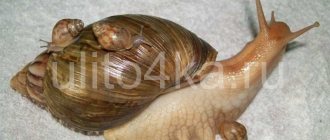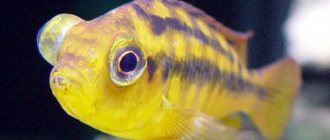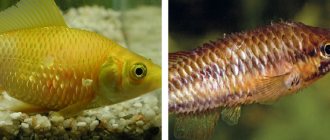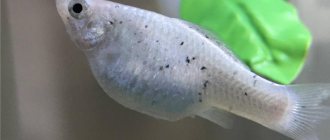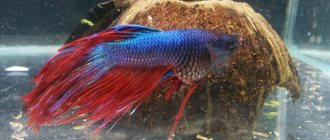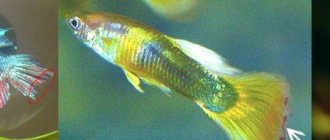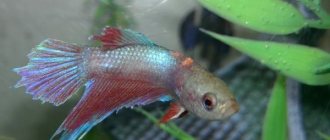Symptoms
Bug eyes are difficult to confuse with another disease. The fish's eyes (or one) become bulging. The outer surface may become whitish, but the inside seems to be filled with some kind of white liquid.
Swelling of the eye occurs due to increased fluid pressure inside the eyeball. The higher the pressure, the more the eyes protrude outward. As a rule, a concomitant complication occurs - clouding of the eye caused by damage to the cornea. Often the situation worsens when pathogenic bacteria settle on the affected tissues of the eye.
Signs of goldfish disease
You can understand that your pet has become a victim of the disease by characteristic physiological signs:
- fluff and white spots on the body;
- bloating;
- red gills;
- rapid breathing;
- rotting on the fins or tail;
- enlarged eyes;
- the appearance of bleeding wounds or ulcers;
- color change;
- ruffled scales;
- loss of appetite;
- decreased activity: the goldfish tries to hide or spends a lot of time near the filter device;
- unnatural body position;
- the fish spends a lot of time on the surface, greedily swallowing air;
- drooping fins.
At the first signs of disease, it is necessary to place the sick fish in a separate tank and contact a veterinarian. The sooner you contact a specialist, the higher the chance of complete healing.
How to treat bulging eyes?
First of all, before starting treatment, it is necessary to determine the cause of the symptoms.
The main factor in the development of infections in fish is reduced immunity. This is facilitated by poor habitat. By reducing the level of harmful substances to normal and thoroughly cleaning the container, the fish will recover in a short time. However, in a more complex case, when the eye is severely damaged and practically falls out of the socket, urgent treatment is necessary.
To begin with, a number of diagnostic measures are carried out that will help identify the type of provocateurs (infections or parasites). In parallel with this, the chemical composition of water is studied. Every day it is necessary to replace part of the water with fresh water to improve the habitat. The preventive effect may last up to one week. The first indicator that you are on the right track will be a decrease in corneal clouding. At this time, you should feed the fish with nutritious and balanced food containing vitamins and microelements. In this way, it will be possible to speed up the healing process by raising the body's defenses.
If the eyeball is severely damaged, magnesium sulfate is used for a speedy recovery. The sick pet is placed in another aquarium with a volume of no more than 20 liters. Add 1-3 tsp to water. drug. After a few days, the film should subside and the eye should gradually decrease in size.
If the infection has affected the internal organs and the entire body of the fish, it is necessary to include antibiotics in the treatment. It is better to entrust the choice of drug to a specialist who will determine the dosage. It is recommended to add the medicine to the food.
Common diseases
Oodiniosis
The disease odoniosis manifests itself in the appearance of white spots throughout the body. The fish becomes restless and rushes around the aquarium. If diagnosed early, oodynia can be cured.
Saprolegniosis
Characterized by the appearance of fluff on the body, fins, and tail. In severe cases, mucus forms on the body and skin ulcerations appear.
This disease is caused by fungi and is characterized by thin threads throughout the body. The fish may become inactive, lethargic, and breathing becomes more frequent. The disease affects individuals living in an unfavorable environment.
Fin rot
The fins and tail become uneven, the color at the edges changes to white. It seems as if the fish were eaten by relatives or other inhabitants of the aquarium. The disease quickly spreads throughout the aquarium and is transmitted to other fish of different breeds, so you need to immediately place the sick individual in a separate tank. The provocateur of rotting fins is often disturbed temperature conditions and overcrowding of the tank. Streptocide helps with fin rot.
Dropsy
A fatal disease caused by crayfish plague bacilli. The disease develops in the circulatory system, leading to complete blood poisoning. A fish can contract dropsy due to injuries to the skin, through open wounds or torn scales. At an early stage, the disease can be cured, but more often the fish dies. If symptoms of dropsy syndrome appear, the fish should be immediately isolated from other inhabitants of the aquarium.
Gill flukes
A fatal disease that can only be cured in its early stages. But the disease often manifests itself at a late stage, when therapeutic measures do not bring results.
Inflammation of the stomach
A disease caused by overfeeding. Often occurs due to improper selection of food, poor quality nutrition, or excess food. In case of inflammation of the stomach, it is necessary to monitor nutrition, provide high-quality food, and include vegetation in the diet.
Tumors
New growths appear on the body that cannot be treated. This is a non-contagious disease, so there is no need to place an individual with the appearance of growths in a separate tank. Only a doctor can diagnose the disease, since the tumor can be confused with signs of other diseases, including overeating.
Dermatomycosis
A fungus that affects weakened representatives. These may be individuals who have suffered a disease, after injury, or due to improper maintenance. The disease is characterized by the appearance of thin white stripes along the body.
Rubella or furunculosis
The bacterial disease furunculosis actively develops at water temperatures of 25 degrees. Most often, the disease furunculosis is caused by eating live food. The bacteria enter the body with daphnia or cyclops. With furunculosis, the fish become lethargic, swim near the surface or at the bottom, and lose their appetite. The scales become ruffled and individual scales fall off. The abdomen with furunculosis is characteristically swollen.
Hexamitosis
The intestinal disease hexamitosis develops due to parasites. Due to parasites, digestion is disrupted, appetite disappears, and metabolism is disrupted. The animal's body, weakened by hexamitosis, quickly weakens, ulcers and papillomas appear on the body. The skin cracks and bursts. Due to intoxication, the fish become lethargic; if hexamitosis is not treated, they die. Hexamitosis is treated with special medications.
Changeling
The disease appears in goldfish due to poor nutrition. Dry food in the diet leads to disorientation: the animal can float on the surface or lie on the bottom. She moves chaotically around the aquarium, often turning over with her belly up. It is necessary to change the fish’s diet and clean the aquarium to normalize the condition.
Swallowing stones
A common problem is swallowing small stones. This breed has a good appetite; they want to eat all the time, so if there is no food, they can take small pebbles from the bottom into their mouths. Usually fish suck on pebbles to eat leftover food and microorganisms from them, but very small stones can be accidentally swallowed.
Pebbles do not always fall into the stomach. Some get stuck in the throat, making it difficult to breathe and eat. The fish slowly dies from lack of oxygen and exhaustion.
Signs of swallowing pebbles:
- the fish has lost its appetite;
- the stomach became sunken;
- weakness;
- the animal spits out food.
If these signs occur, your mouth should be checked. You may see the edge of a pebble or other object. You can remove it with tweezers or consult a doctor.
A swallowed stone can block the intestines, leading to her inevitable death. Experts recommend buying large or medium-sized stones as soil for goldfish that will not fit in the animal’s mouth.
Fish diseases are a nuisance that even an experienced aquarist faces. Even experienced aquarists encounter this problem. There is no need to panic or causelessly worry. Watch the fish carefully. If signs of illness are obvious, contact your veterinarian.
Causes
As mentioned earlier, bulging eyes are caused by viral, bacterial and fungal infections. However, factors that provoke the development of the disease can also be nematodes and trematodes in the eye, vitamin deficiency and physiological disruptions of the body.
In many cases, the only cause of illness in aquarium fish was dirty water, and in order to cure the fish, it was enough to clean and improve it, without the use of antibiotics and other drugs.
It is quite possible to detect the initial stage of exophthalmia. Before fluid begins to collect in the eye, the cornea becomes cloudy and turns whitish. In case of illness due to infection, abdominal distension will be added to the cloudiness.
We recommend reading the article: Diseases of aquarium fish
Prevention
Prevention will help reduce the risk of disease in these beautiful aquarium inhabitants. Here are some simple recommendations:
- Plants, decor and new equipment should be thoroughly washed before being placed in the fish tank.
- All new pets must be quarantined for a week.
- All decor and soil should not have sharp edges so that the inhabitants do not damage their bodies.
- It is important to avoid overcrowding to avoid oxygen deficiency. For 4-5 individuals you will need a 100 liter aquarium (for two fish a 50 liter tank is suitable).
- Ensure a normal oxygen supply (installing a filter with aeration will help).
- It is important to have living plants that have a positive effect on the microclimate.
- You need to feed on a schedule at the same time.
- You need to change the water quite often - at least once a week.
Treating aquarium fish is a complex process that requires experience, knowledge and additional resources. Therefore, it is better to turn to professionals if your pets are already sick. Remember that goldfish should be treated by qualified staff, and your task is to admire them and follow the recommendations for caring for them.
Treatment
Determine and eliminate the cause of this disease. Prompt action taken at the first sign of bulging eyes is very important to prevent permanent eye damage or loss. If there are no signs of a pathogenic or parasitic disease, then we can conclude that the cause of the disease is related to the environment - for example, chemical composition or water quality. Even if these parameters are in the range acceptable for fish of a given species, it is still worth performing a partial water change every 2-3 days, since such a measure often leads to a cure for the fish. It may take a week for the swelling to completely disappear. But if the root of the problem is water quality, then the clouding of the cornea that almost invariably accompanies this type of exophthalmos will disappear much more quickly, indicating that the treatment has been effective.
Symptoms
One or both eyes swell and protrude from their sockets. In extreme cases, the eye can literally “fall out” of its socket and become lost. Cloudiness of the entire outer surface of the eye is accompanied or preceded by exophthalmos. If exophthalmos is associated with a systemic infection (see below), then signs of this infection - for example, bloating - may be observed at the same time.
This is an eye disease that is properly called exophthalmia or exophthalmos. It is a symptom of some internal disease caused by pathogenic organisms or environmental conditions, and not an independent disease. However, aquarists perceive it precisely as a separate disease.
